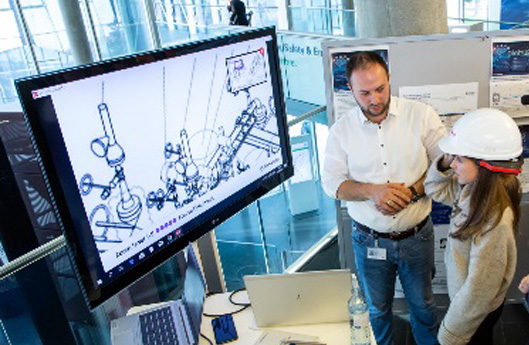Digitalization in Upstream
OMV aims to advance into the league of digital frontrunners in the Upstream industry. Digitalization helps optimize operations and processes for higher efficiency, improve HSSE performance, and increase profitability. At the same time, digital technologies and the resulting deployment of new capabilities will not just make OMV more attractive to new employees but will also open the door to new partnerships with operators and suppliers.
Our digital roadmap consists of the following five lighthouses ranging from the business agility programs Digital Twins, Digital Oilfield, and Digital Rig to Digital Ways of Working and Digital Office of the Future. The roadmap contains more than 70 projects and use cases.
Integrated Digital Twins from subsurface to facilities
This program focuses on subsurface-related matters ranging from exploration to development within OMV’s supply chain. Multiple evergreen reservoir models will enable end-to-end value creation through informed decision-making under rigorous management of uncertainty. The aim is a unified ecosystem which will integrate workflows, technology, and data with personal knowledge, assisted by artificial intelligence. No search will be required for information and tools; instead, they are available anytime. The data is accessible through a personalized cockpit with all the decision-relevant information, so all employees can contribute to fast and effective decision-making.
For example, the Digital Rock project creates Digital Twins of real rocks with all their components in the micrometer range. The Digital Twins will be part of the high-performance computing (HPC) environment and deliver deep insight into our reservoir properties. Compared to traditional rock scanning, this yields fast results, uses less hazardous chemicals for laboratory measurements, and helps improve the quality of our exploration and development activities.
Real-time digital oilfield
This program aims to expand the options for safer, greener, and more efficient operations through strategic integrated digital technology deployment. A recent example is a robotic drone that conducted routine condition inspections of the largest crude oil storage tanks in a fraction of the time and at lower costs, while completely eliminating the risk to human life when working at height and entering confined spaces. In addition, robotic crawlers with magnetic pads are currently being tested to perform paint blasting and reconditioning of external corrosion protection, thus eliminating the extreme risks linked to having humans perform this work.

Advanced Process Control systems are in the testing phase to implement an algorithm-based predictive model that helps the operators control and optimize the facilities at all times in order to operate at the most efficient operating point possible. This reduces internal consumption of energy, decreases the carbon footprint, and increases the efficiency of processing chemicals, thus optimizing production costs.
The Digital Worker (also called “remote operator”) stream includes the technology for streaming high-quality images and information from the drilling and operational sites all over the world to OMV experts. This enables them to provide the right support and decisions remotely without the need to travel long distances to safety-risk areas.
Digital rig of the future
The RigUP program enables the custom design and construction of an automated robotic rig, featuring custom software and an innovatively powered drillpipe. RigUP aims to implement an unmanned rig floor as well as reliable high-speed data feeds and innovative rig sensors for effective and efficient remote well-construction monitoring. This will remove a persistent source of harm to personnel on the rig site, thus fulfilling OMV’s Vision of “ZERO harm – NO losses.”
New drilling technology that will come into force in 2020 will allow us to use less fuel per well due to faster drilling. At the same time, a smarter supply chain system between suppliers, warehouses, and the rigs will reduce traffic to the well site, leading to reduced CO2 and NOx emissions. Increasing performance and optimizing the wells will require fewer workover operations to maintain production and thus will create a safer work environment.
Digital Ways of Working
This lighthouse aims at building OMV Upstream in such a way that we are resilient to the market and always competitive at our core – maximizing our digitalization return will increase speed to maneuver.
Upstream’s organization, team, and people will seize opportunities wherever they arise and be empowered to contribute to value creation in a sustainable manner. One focus area will be to enable our most valuable asset – our employees – to take Upstream’s digital journey by developing digital competencies and skills. Collaboration with the Corporate Culture initiative (for more details, see Beyond technology – working differently) is embedded in this lighthouse to ensure that Upstream’s front-runner vision includes the Group-wide Digital Journey.
Digital Office of the Future
Digitalization is based on data. This program therefore focuses on OMV’s data backbone to create a digitalized OMV Upstream frontrunner organization. We are building a flexible and globally high-performance, secure infrastructure for our staff by using latest cloud and integration technologies, providing access to state-of-the-art integrated applications and quality-assured data and knowledge.
One example is the GeoCloud platform, which allows users to run geoscience applications that require large amounts of electricity and computing power to collaborate globally on projects and workflows. This has already been rolled out at eight out of ten OMV locations and allows 400 users to access 1.6 PB of geological data and 170 applications from any device around the world. In addition, GeoCloud provides the flexibility and scalability to quickly deploy a virtual office by improving the security of data and people exposed to high-risk regions. The GeoCloud application will be the basis for further projects, such as high-performance computing (HPC), which is crucial for obtaining data for machine learning and artificial intelligence methods to enable data-driven decision-making. The HPC environment on Microsoft Azure is currently set up to reduce simulation times and increase resolution by a factor of 10 each using a globally unlimited license model.